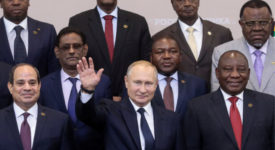Africa, I recently noted, “accounts for 17% of the world’s population, but only 3% of global GDP.” This stark imbalance means that, in the years ahead, Africa will be either a source of “global instability and extremism” or a major source of global growth. One has only to look at economic and demographic trends to understand why the first outcome seems more likely. According to IMF estimates, whereas the US accounts for $22.3 trillion of annual GDP, and China for $15.3 trillion, Africa’s combined GDP is only around $2.6 trillion. At the same time, the UN’ World Population Prospects 2019 suggests that by 2100, Africa will comprise 4.3 billion of the world’s 10.9 billion people, owing to high fertility, rising life expectancy, declining child mortality, and other factors. This “wrong-way” relationship between economic and demographic trends portends a future of poverty, urban decay, hunger, chaos, and extremism for around 40% of the world’s people by 2100.
If Africa is to avoid the grim fate that the data seem to predict, the continent urgently needs to accelerate structural economic reforms and achieve higher rates of growth. But to double its share of global economic growth in the next 20 years, and to quadruple it in the next 40 years, the region’s GDP must grow at a compounded average rate of 6% per year, which is one full point above what it has recorded over the past two decades.These calculations imply that Africa’s real GDP would rise from $2.6 trillion today to $26.5 trillion in 40 years – a massive economic leap forward. But even if realized, it still would not come close to closing the gap between Africa’s share of world population and its share of world GDP.Moreover, the risks to the region are enough to skew growth forecasts to the downside. If African economies falter, the region will be left even poorer, with profound humanitarian and geopolitical ramifications. The African challenge is thus a global challenge. And, in my estimation, it is one of the least understood challenges of the 21stcentury.
Africa’s global importance is certainly recognized by today’s great powers, the US and China. Indeed, two new schemes introduced in 2018 indicate the terms on which the world’s two largest economies now view global engagement in Africa: China’s Forum on China-Africa Cooperation (FOCAC) and the US’ “Prosper Africa Initiative”. China’s scheme is characterized by a “five-no”, namely “no interference in the development paths of individual countries; no interference in their internal affairs; no imposition of China’s will; no attachment of political strings regarding assistance; and no seeking of selfish political gains in investment and financing cooperation.” China will thus provide $60 billion in financing for eight initiatives – industrial promotion, infrastructure cooperation, trade facilitation, green development, capacity building, health care, people-to-people exchange, and peace and security – to be carried out over the next three years.
This kind of development strategy is not new. But the tone, depth, and comprehensiveness of China’s commitments in Africa are noteworthy. Clearly, the Chinese government’s interest in the continent is driven by its own economic and diplomatic objectives (for example, to secure broader support at the UN for its Taiwan policy) as well as its need for resources (food, minerals, and crude oil) and wider markets. But it also recognizes that sustained growth and development in Africa is in the world’s interest. China, perhaps more than any other country, understands the outsize growth opportunity that would be created by a great economic leap forward in Africa. It is thus extremely well positioned to capitalize.
As for the Trump administration’s initiative, the goal is to “substantially increase two-way trade and investment between the US and Africa,” by providing “a one-stop shop that makes the full range of [US trade and investment-support] services available.” Trump’s then-national security adviser, John Bolton, explained that the “strategy addresses three core US interests on the continent: “First, advancing US trade and commercial ties with nations across the region … Second, countering the threat from Radical Islamic Terrorism and violent conflict … and third, [to] ensure that US taxpayer dollars for aid are used e?ciently and e?ectively.” The problem is, however, that the Prosper Africa initiative “risks being a statement of good intentions with no teeth or additive resources.” Since then, the US has launched the $60 billion International Development Finance Corporation to replace the US Overseas Private Investment Corporation.
In examining the US and China’s track records in Africa, many may be surprised to learn that the US is neither largely absent from the continent, as one often hears, nor outmatched by China in terms of engagement. Nonetheless, China did surpass the US as Africa’s largest trading partner a decade ago, in 2009. As of 2017, Chinese trade turnover with Africa ($148 billion) was approximately three times that of the US ($55 billion). China accounts for 15-16% of Sub-Saharan Africa’s exports and 14-21% of its imports. And according to Standard Bank, “Around two-thirds of African countries list China as their largest source of goods.”For the US, one source of trade tension with Africa has been the qualifying criteria for the US Generalized System of Preferences under the 2000 US African Growth and Opportunity Act. But despite these issues, the AGOA remains a powerful tool. By providing duty-free access for most African products, AGOA has helped expand and diversify African exports to the US. In 2015, the US Congress extended the act through 2025, enabling a $39 billion increase in trade turnover between the US and Sub-Saharan Africa in 2017.
Another key area is development and infrastructure financing. According to William & Mary’s AidData project, China has financed more than 3,000 large infrastructure projects in Africa, extending more than $86 billion in low-interest commercial loans to African governments between 2000 and 2014, or $6 billion per year on average. Meanwhile, the US government’s official development aid to Africa over the last decade has come to around $9 billion per year on average. Nonetheless, in 2015, China pledged a further $60 billion in loans to Africa, implying an increase in Chinese funding of $20 billion per year. Moreover, Beijing committed yet another $60 billion over the next three years, which means that China may already now be outpacing the US as a source of government-provided funding to Africa.According to a 2017 report from Ernst & Young, the US was the largest overall investor in Africa, with annual US foreign direct investment averaging more than $3.5 billion per year between 2003 and 2015, compared to China’s $2.2 billion. But at the 2018 FOCAC summit, Xi, perhaps aware that China was lagging on FDI, implored “Chinese companies to make at least $10 billion of investment in Africa in the next three years.” In terms of the foreign direct investments (FDI), while the US has led the FDI drive into Africa ($50 billion in 2017, down from a peak of $69 billion in 2014), China has been gaining ground quickly ($43 billion in 2017, up from $16 billion in 2011).
Finally, there is the critical issue of military activity and support for peace missions in Africa, both of growing importance given the mushrooming Islamist insurgencies in the Sahel. According to CSIS, while the US has only one o?cial permanent military base in Africa, it has approximately 6,000 troops on the continent, with around 100 missions in 20 countries. But in 2018, the US Department of Defense announced a 10% reduction in US troops stationed in Africa.For its part, China has one military base in Djibouti. But by March 2017, writes Eleanor Albert of the Council on Foreign Relations, “more than 2,500 Chinese troops, police, and military experts had been dispatched to six UN peacekeeping missions in Africa.” Not only that, but in 2015, “Xi pledged $100 million in military aid to the African Union in 2015, and China supports African countries’ capacity building in areas like defense and counterterrorism.”
Still, relative to the size of their overall arsenals, both the US and China maintain a low-intensity military presence in Africa. This is somewhat surprising given the security risks the region poses. According to the Global Terrorism Database, 10,819 of the 26,445 deaths due to terrorism in 2017 were in the Middle East and North Africa, and another 6,712 were in Sub-Saharan Africa, which means that the region overall accounted for two-thirds of all terrorism deaths globally that year.To sum up the state of play: China already has a significant lead over the US with respect to African trade, and it is taking the lead on development financing as well. While the US remain first in terms of FDI, the Chinese are closing the gap. And both countries are under-invested in the continent militarily, despite the growing threat of international terrorism and calls for peacekeeping missions.
China and the US understand that in a globally interconnected world, Africa cannot be walled off or ignored. But their initiatives on the continent, however ambitious, will hardly be adequate to Africa’s needs. Indeed, there are already 2.1 million African migrants in the US, and 10.6 million in Europe. And with climate change, terrorism, and conflict likely to worsen in Africa in the years ahead, international migrant and refugee flows from the continent will accelerate.Now is the time to assist Africa with systematic programs across all critical development areas: education and health; state administration, training, and capacity-building; investment, aid, and market access; infrastructure; job creation; trade support; agricultural and industrial development; technology and innovation; intelligence and policing; and security. To be sure, Africans must lead these e?orts, but global support is needed to buttress them.
Besides, with the potential to grow by as much as $600 billion per year, Africa represents a massive opportunity for investors. The world’s leading powers thus have a direct interest in positioning the continent for success. That, ultimately, is why it matters how the world’s two largest national economies engage with Africa. Each needs to lead with a long-term strategy as well as tactical interventions to forestall brewing crises. Equally important, both the US and China need to cooperate when it comes to ensuring Africa’s own long-term interests.As Africa’s most developed country and its leading representative in international forums, South Africa and its president, Cyril Ramaphosa, now the chair of the African Union, have a special role to play in pushing China, the US, and the G20 to step up their efforts in Africa. The G20 and the BRICS bloc each has plans for the continent, but these need to be strengthened, funded, and pursued with new resolve.
The US, in particular, needs to improve its engagement. As an overall strategy, Prosper Africa is incomplete at best. Compared to China’s eight-point plan, it is under-resourced, limited in scope, and narrowly targeted. On its own, it o?ers little hope that the US will arrest the decline in its economic position on the continent, relative to China. The US would do well to take a longer-term view of the strategic imperatives and commercial opportunities in Africa.As for African leaders, it is clearly in the continent’s interest to have several options when seeking alliances and engagement from abroad. Africa’s international representatives should be encouraging further engagement from multiple sources, to avoid ending up in a situation where the continent must deal with just one dominant power.By the end of this century, two out of every five humans will be living in Africa. The effort to meet their needs must, of course, be led by Africans themselves. But the rest of the world can no longer look at Africa’s fate with indifference, or merely through the prism of great-power rivalries. Africa’s problems are our problems, and we must join with Africa in finding the solutions to them.
‘The Sino-American Scramble For Africa’ – Opinion by Colin Coleman – Project Syndicate.
(The Opinion can be downloaded here:
https://www.project-syndicate.org/onpoint/us-china-africa-engagement-by-colin-coleman-2020-03?a_la=english&a_d=5e749442c7fdb940f456f15c&a_m=&a_a=click&a_s=&a_p=homepage&a_li=us-china-africa-engagement-by-colin-coleman-2020-03&a_pa=onpoint&a_ps=&a_ms=&a_r=&barrier=accesspaylog)





